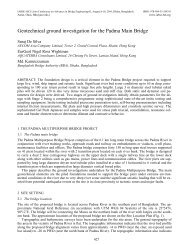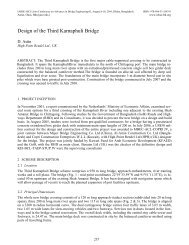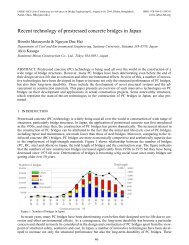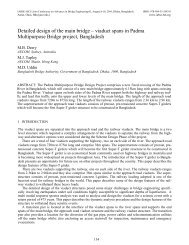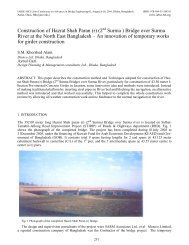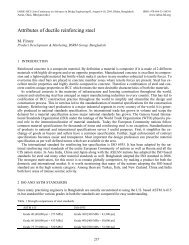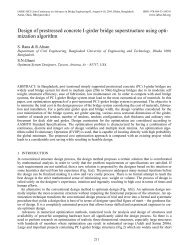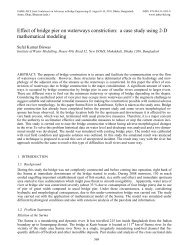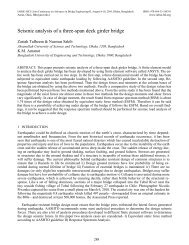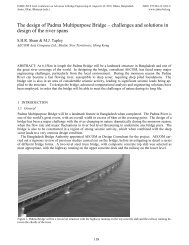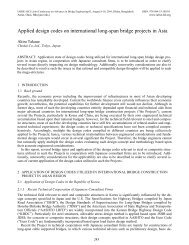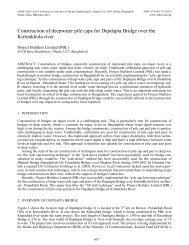Souvenir - Bangladesh Group of IABSE
Souvenir - Bangladesh Group of IABSE
Souvenir - Bangladesh Group of IABSE
You also want an ePaper? Increase the reach of your titles
YUMPU automatically turns print PDFs into web optimized ePapers that Google loves.
i) The length <strong>of</strong> the PC girder for this bridge is 48.470m. This is the maximum length <strong>of</strong> pre-cast 1-<br />
girder or T-girder constructed using the launching girder available in the country. Besides the cast<br />
in -situ construction <strong>of</strong> such a large size girder using shoring embedded in the s<strong>of</strong>t bed material at<br />
the bridge site has risks <strong>of</strong>formwork settlement. It is therefore considered advisable to select such<br />
structural option and construction methodology <strong>of</strong> the foundations whereby the possibility <strong>of</strong><br />
increase in the span length due to tilt and shift <strong>of</strong> the foundations could be minimized.<br />
ii) The sub soil investigation conducted adjacent to the pier locations shows s<strong>of</strong>t to firm, firm to stiff<br />
soil having SPT values between 4 and 7 up to about 14m depth below the existing bed level. The<br />
harder strata is encountered below. From design point <strong>of</strong> view, well is an ideal structural option in<br />
such soil. However, from the construction point <strong>of</strong> view the existence <strong>of</strong> the s<strong>of</strong>t soil in the top<br />
strata increase the risks <strong>of</strong> tilt and shift <strong>of</strong> the well. The usual method <strong>of</strong> construction involves<br />
developing an artificial island with its top at about the normal high water level. The construction<br />
<strong>of</strong> well will be made from that platform. The contract design shows the top <strong>of</strong> well cap at EI O.OOm<br />
PWD whereas the natural bed level around the pier is at about El. -7.00 to -7 .50m PWD in deep<br />
water. This gives the unsupported height <strong>of</strong> well above the river bed level about 7.00 to 7.50m.<br />
The artificial island <strong>of</strong> this height supported on the s<strong>of</strong>t soil is likely to incur considerable vertical<br />
settlement. Further, the required embedment length <strong>of</strong>the peripheral tubular supports sustaining<br />
the lateral earth pressure for this height <strong>of</strong> backfill will also considerable.<br />
iii) The three years construction period is likely to provide maximum two working seasons for<br />
construction <strong>of</strong> all the six wells, otherwise completion <strong>of</strong> the work within the contract period<br />
might be difficult. The harder strata underlying the top s<strong>of</strong>t strata is again likely to reduce the rate<br />
<strong>of</strong> penetration <strong>of</strong> the wells considerably. The sinking <strong>of</strong> the 31.5m length <strong>of</strong> well might even<br />
consume the whole <strong>of</strong> the available three working seasons. This means even if all the six wells are<br />
started at one time, the completion <strong>of</strong> wells themselves might consume the entire contract period,<br />
due to the field subsoil conditions.<br />
iv) This will necessitate maintaining the wells during the three flood seasons. The six rectangular<br />
shaped islands with semi-circular noses inside river, having plan size <strong>of</strong> about 20.00m width x<br />
30.00m length is likely to constrict the passageway <strong>of</strong>the flood water, and thereby enhancing the<br />
local scour around the island considerably. The observed maximum scour depth at that case might<br />
exceed the design value. If the construction is further delayed, this constriction <strong>of</strong> the water way<br />
might affect the morphology or the regime <strong>of</strong> the river permanently.<br />
v) Further, although from the structural point <strong>of</strong> view the steining thickness <strong>of</strong> the designed RCC<br />
caisson is found adequate, it might not be found adequate from the construction point <strong>of</strong> view. To<br />
facilitate sinking <strong>of</strong> caisson in the hard strata needs overcoming the skin friction on the surface <strong>of</strong><br />
the well. The relevant Indian Road Congress (lRC) code recommends about double steining<br />
thickness than provided in the contract drawings from construction point <strong>of</strong> view, which<br />
increases cost. In addition, sinking <strong>of</strong> well will need further kentledge arrangement.<br />
vi)<br />
The other pier and abutment foundations comprising 0.35 m x 0.35m size x28.00m long precast<br />
piles may also generate difficulties in construction in the lower hard strata. The long precast<br />
slender piles might require to be driven in two pieces. This will require normally expensive<br />
patented moment splicing, for example, Hercules splicing or equivalent, which is difficult to be<br />
mobilized for this local currency project.<br />
An alternative design replacing the caisson/precast pile foundations below piers/abutments, by 1/0.76mdia<br />
cast in-situ bored pile foundations for both abutments and piers are proposed. This, compared to the



